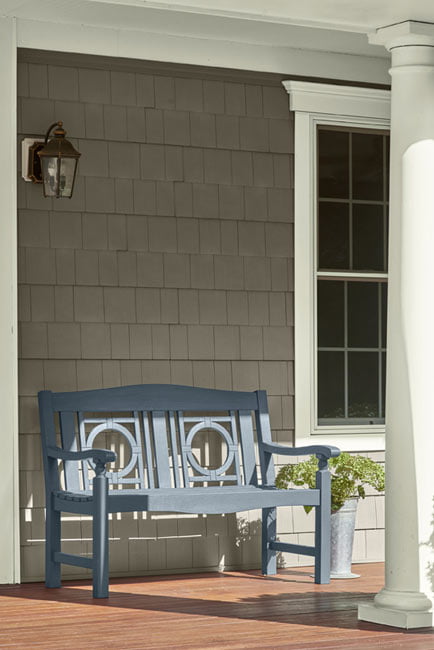New color doesn’t have to mean new siding: Refresh your vinyl with these popular Benjamin Moore colors—all tested and proven to perform well under all weather conditions.
The Colors for Vinyl palette provides a dynamic, lively selection of paint color favorites that will reinvigorate any vinyl-sided home.
Yes: You Can Paint Vinyl Siding
Painting your vinyl siding is not only less expensive than replacing it, painting vinyl siding with our Colors for Vinyl palette gives you the creative freedom that comes with choosing a fresh color scheme for an entirely new look.
Our carefully edited palette of 75 handpicked colors, Colors for Vinyl, makes it easier than ever to choose. The curated palette offers a wide range of tried and true hues, from Revere Pewter HC-172 to rich hues like New Hope Gray 213-50, to the classic Simply White OC-117 and more. These designer-essential paint colors are available in select Benjamin Moore exterior paint lines, giving you product choice too.
Yes: You Can Paint Vinyl Siding
Painting your vinyl siding is not only less expensive than replacing it, painting vinyl siding with our Colors for Vinyl palette gives you the creative freedom that comes with choosing a fresh color scheme for an entirely new look.
Our carefully edited palette of 75 handpicked colors, Colors for Vinyl, makes it easier than ever to choose. The curated palette offers a wide range of tried and true hues, from Revere Pewter HC-172 to rich hues like New Hope Gray 213-50, to the classic Simply White OC-117 and more. These designer-essential paint colors are available in select Benjamin Moore exterior paint lines, giving you product choice too.
Most Popular Vinyl Siding Colors
Abalone
2108-60
White Wisp
OC-54
Smoked Oyster
2109-40
Stonington Gray
HC-170
Tea Room
AF-270
Coventry Gray
HC-169
Seashell
OC-120
Horizon
OC-53
Sandy White
2148-50
Wedgewood Gray
HC-146
Hawthorne Yellow
HC-4
Louisburg Green
HC-113
The Beauty of the Black Living Room
Black walls can look great in any room. Often the rooms that are most successful have a balance between light and dark, where black walls are paired with a light floor color or furniture is upholstered in neutrals and white.
Black paint has an interesting effect on the walls of a room because the corners and shadows are obscured more than if a mid-tone or pastel color is used. This visual trick blurs the boundaries in a space and can make a room feel a bit more expansive.
Questions?
we're here for you.
Frequently Asked Questions
When touching up a hole repair, why do I notice a difference, why is the color different?
Paint ages and loses sheen over time, so even within 3 months of painting, the wall is now less shiny than the touch up, meaning it will stand out more. In time the touch up will dull down and blend in a little, but the touchup must be applied lightly in order to keep the wall looking as close to uniform as possible.
Should I do two coats?
You should always do two coats for the following reasons:
-Uniform color - if you only do one coat there is no guarantee that the color will be uniform if the previous color is showing through due to improper film build.
-When doing a color change you should definitely not rely on one coat, depending on what you’re changing to, 2 coats is usually enough.
Do I need to prime?
Priming is necessary when you have new drywall/drywall mud to seal it so that it doesn’t absorb more paint than is needed. Also if doing a color change from dark to light 1 coat of primer might be recommended in order to achieve the desired color.
Why do I need to wait for the paint to dry?
The re-coat window is necessary to ensure that your 2nd coat doesn’t re-wet the first coat. Applying paint too early can just re-activate the previously applied coat of paint, meaning that you don’t get a proper two coat film build, and so it doesn’t cover as two proper coats.
How long do I wait to be able to wash my walls
Most paints require 28 days to full harden and cure, giving you maximum durability for the product. only ever wash your walls with warm soapy water, avoiding bleach or ammonia based cleaning products.




















